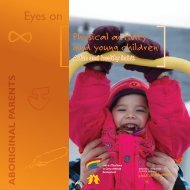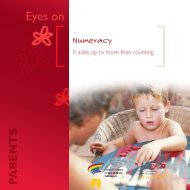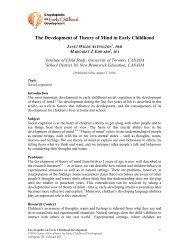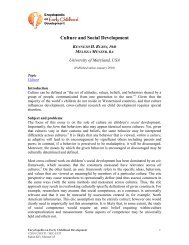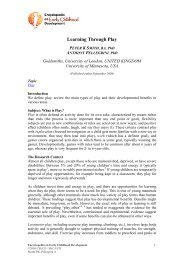Curriculum and Play in Early Child Development - Encyclopedia on ...
Curriculum and Play in Early Child Development - Encyclopedia on ...
Curriculum and Play in Early Child Development - Encyclopedia on ...
Create successful ePaper yourself
Turn your PDF publications into a flip-book with our unique Google optimized e-Paper software.
Topic<br />
<str<strong>on</strong>g>Play</str<strong>on</strong>g><br />
<str<strong>on</strong>g>Curriculum</str<strong>on</strong>g> <str<strong>on</strong>g>and</str<strong>on</strong>g> <str<strong>on</strong>g>Play</str<strong>on</strong>g> <str<strong>on</strong>g>in</str<strong>on</strong>g> <str<strong>on</strong>g>Early</str<strong>on</strong>g> <str<strong>on</strong>g>Child</str<strong>on</strong>g> <str<strong>on</strong>g>Development</str<strong>on</strong>g><br />
ELENA BODROVA, PhD<br />
DEBORAH J. LEONG, PhD<br />
Mid-c<strong>on</strong>t<str<strong>on</strong>g>in</str<strong>on</strong>g>ent Research <strong>on</strong> Educati<strong>on</strong> <str<strong>on</strong>g>and</str<strong>on</strong>g> Learn<str<strong>on</strong>g>in</str<strong>on</strong>g>g, USA<br />
Metropolitan State College of Denver, USA<br />
(Published <strong>on</strong>l<str<strong>on</strong>g>in</str<strong>on</strong>g>e September 2010)<br />
Introducti<strong>on</strong><br />
The need to <str<strong>on</strong>g>in</str<strong>on</strong>g>tegrate play <str<strong>on</strong>g>in</str<strong>on</strong>g>to early childhood curriculum has been supported by decades<br />
of child development research <str<strong>on</strong>g>and</str<strong>on</strong>g> is reflected <str<strong>on</strong>g>in</str<strong>on</strong>g> the most recent documents of such<br />
professi<strong>on</strong>al organizati<strong>on</strong>s as Nati<strong>on</strong>al Associati<strong>on</strong> for the Educati<strong>on</strong> of Young<br />
<str<strong>on</strong>g>Child</str<strong>on</strong>g>ren 1,2 <str<strong>on</strong>g>and</str<strong>on</strong>g> Nati<strong>on</strong>al Research Council. 3,4 However, the specific aspects of the<br />
relati<strong>on</strong>ship between play <str<strong>on</strong>g>and</str<strong>on</strong>g> curriculum rema<str<strong>on</strong>g>in</str<strong>on</strong>g> open to <str<strong>on</strong>g>in</str<strong>on</strong>g>terpretati<strong>on</strong> which affects the<br />
beliefs of <str<strong>on</strong>g>Early</str<strong>on</strong>g> <str<strong>on</strong>g>Child</str<strong>on</strong>g>hood practiti<strong>on</strong>ers as well as their classroom practices.<br />
Subject<br />
One of the reas<strong>on</strong>s for the existence of many <str<strong>on</strong>g>in</str<strong>on</strong>g>terpretati<strong>on</strong>s is the apparent c<strong>on</strong>tradicti<strong>on</strong><br />
between the mean<str<strong>on</strong>g>in</str<strong>on</strong>g>g of the words “play” <str<strong>on</strong>g>and</str<strong>on</strong>g> “curriculum” prevalent both <str<strong>on</strong>g>in</str<strong>on</strong>g> professi<strong>on</strong>al<br />
literature <str<strong>on</strong>g>and</str<strong>on</strong>g> <str<strong>on</strong>g>in</str<strong>on</strong>g> everyday language used by teachers <str<strong>on</strong>g>and</str<strong>on</strong>g> parents of young children: the<br />
former has been typically thought of as a sp<strong>on</strong>taneous child-<str<strong>on</strong>g>in</str<strong>on</strong>g>itiated activity that does not<br />
serve any practical need 5 while the latter has been associated with <str<strong>on</strong>g>in</str<strong>on</strong>g>tenti<strong>on</strong>al teach<str<strong>on</strong>g>in</str<strong>on</strong>g>g<br />
designed to accomplish clear <str<strong>on</strong>g>in</str<strong>on</strong>g>structi<strong>on</strong>al objectives. 6 Furthermore, play is not a s<str<strong>on</strong>g>in</str<strong>on</strong>g>gular<br />
c<strong>on</strong>struct but rather a c<strong>on</strong>t<str<strong>on</strong>g>in</str<strong>on</strong>g>uum of playful behaviours that children engage <str<strong>on</strong>g>in</str<strong>on</strong>g> the c<strong>on</strong>text<br />
of <str<strong>on</strong>g>Early</str<strong>on</strong>g> <str<strong>on</strong>g>Child</str<strong>on</strong>g>hood classrooms, encompass<str<strong>on</strong>g>in</str<strong>on</strong>g>g a set of behaviours that vary <str<strong>on</strong>g>in</str<strong>on</strong>g> terms of<br />
the degree of adult guidance <str<strong>on</strong>g>and</str<strong>on</strong>g> support. 7<br />
Research C<strong>on</strong>text <str<strong>on</strong>g>and</str<strong>on</strong>g> Recent Research Results<br />
Research <strong>on</strong> play <str<strong>on</strong>g>in</str<strong>on</strong>g> the c<strong>on</strong>text of <str<strong>on</strong>g>Early</str<strong>on</strong>g> <str<strong>on</strong>g>Child</str<strong>on</strong>g>hood Educati<strong>on</strong> has addressed two aspects<br />
of the play-curriculum relati<strong>on</strong>ship. One set of researchers look <str<strong>on</strong>g>in</str<strong>on</strong>g>to the use of play<br />
elements, play envir<strong>on</strong>ments, or play motivati<strong>on</strong> as a way to enhance <str<strong>on</strong>g>in</str<strong>on</strong>g>structi<strong>on</strong> <str<strong>on</strong>g>in</str<strong>on</strong>g> core<br />
subjects such as literacy, 8,9 mathematics 10,11 or science, 12 or as a way to promote specific<br />
areas of development such as the development of children’s social-emoti<strong>on</strong>al<br />
competencies, 13 oral language 14,15 or gross <str<strong>on</strong>g>and</str<strong>on</strong>g> f<str<strong>on</strong>g>in</str<strong>on</strong>g>e motor skills, 16 etc. These studies are<br />
primarily focused <strong>on</strong> the respective academic doma<str<strong>on</strong>g>in</str<strong>on</strong>g> or area of development with play<br />
viewed as a means to foster child development <str<strong>on</strong>g>in</str<strong>on</strong>g> these doma<str<strong>on</strong>g>in</str<strong>on</strong>g>s. When communicated to<br />
<str<strong>on</strong>g>Early</str<strong>on</strong>g> <str<strong>on</strong>g>Child</str<strong>on</strong>g>hood educators, results of these studies are translated <str<strong>on</strong>g>in</str<strong>on</strong>g>to practical<br />
<str<strong>on</strong>g>Encyclopedia</str<strong>on</strong>g> <strong>on</strong> <str<strong>on</strong>g>Early</str<strong>on</strong>g> <str<strong>on</strong>g>Child</str<strong>on</strong>g>hood <str<strong>on</strong>g>Development</str<strong>on</strong>g> 1<br />
©2010 CEECD / SKC-ECD<br />
Bodrova E, Le<strong>on</strong>g DJ
PLAY<br />
suggesti<strong>on</strong>s <strong>on</strong> how to create math- or literacy-rich play envir<strong>on</strong>ments <str<strong>on</strong>g>and</str<strong>on</strong>g> <strong>on</strong> how to<br />
<str<strong>on</strong>g>in</str<strong>on</strong>g>corporate math, science or literacy language <str<strong>on</strong>g>in</str<strong>on</strong>g>to children’s play. 17<br />
At the same time, there is a l<strong>on</strong>g st<str<strong>on</strong>g>and</str<strong>on</strong>g><str<strong>on</strong>g>in</str<strong>on</strong>g>g traditi<strong>on</strong> <str<strong>on</strong>g>in</str<strong>on</strong>g> play research that focuses <strong>on</strong> play<br />
itself <str<strong>on</strong>g>in</str<strong>on</strong>g> its multiple forms (e.g., social, pretend or object), recogniz<str<strong>on</strong>g>in</str<strong>on</strong>g>g it as a dist<str<strong>on</strong>g>in</str<strong>on</strong>g>ct<br />
child-<str<strong>on</strong>g>in</str<strong>on</strong>g>itiated activity with its own unique c<strong>on</strong>tributi<strong>on</strong>s to child development. These<br />
c<strong>on</strong>tributi<strong>on</strong>s are associated with the development of broader competencies such as<br />
theory of m<str<strong>on</strong>g>in</str<strong>on</strong>g>d, 18 symbolic representati<strong>on</strong>, 19 <str<strong>on</strong>g>and</str<strong>on</strong>g> self-regulati<strong>on</strong> 20 that not <strong>on</strong>ly affect<br />
child development <str<strong>on</strong>g>in</str<strong>on</strong>g> early years but have l<strong>on</strong>g last<str<strong>on</strong>g>in</str<strong>on</strong>g>g effect <str<strong>on</strong>g>in</str<strong>on</strong>g> the school years <str<strong>on</strong>g>and</str<strong>on</strong>g><br />
bey<strong>on</strong>d. Traditi<strong>on</strong>ally, the majority of studies from this perspective have been d<strong>on</strong>e <str<strong>on</strong>g>in</str<strong>on</strong>g><br />
naturalistic sett<str<strong>on</strong>g>in</str<strong>on</strong>g>gs with children engaged <str<strong>on</strong>g>in</str<strong>on</strong>g> free play with little or no adult guidance.<br />
Recommendati<strong>on</strong>s for the curriculum emphasize the provisi<strong>on</strong> of adequate physical<br />
spaces <str<strong>on</strong>g>and</str<strong>on</strong>g> props to support play as well as the need to allow ample time for children’s<br />
free play <str<strong>on</strong>g>in</str<strong>on</strong>g> the preschool daily schedule <str<strong>on</strong>g>and</str<strong>on</strong>g> preserve or <str<strong>on</strong>g>in</str<strong>on</strong>g>crease recess time for<br />
k<str<strong>on</strong>g>in</str<strong>on</strong>g>dergartners <str<strong>on</strong>g>and</str<strong>on</strong>g> children <str<strong>on</strong>g>in</str<strong>on</strong>g> the primary grades. 21,22<br />
Key Research Questi<strong>on</strong>s <str<strong>on</strong>g>and</str<strong>on</strong>g> Research Gaps<br />
One of the areas that deserve further <str<strong>on</strong>g>in</str<strong>on</strong>g>vestigati<strong>on</strong> is the relati<strong>on</strong>ship between the quality<br />
of play <str<strong>on</strong>g>and</str<strong>on</strong>g> children’s learn<str<strong>on</strong>g>in</str<strong>on</strong>g>g <str<strong>on</strong>g>and</str<strong>on</strong>g> developmental outcomes. It is becom<str<strong>on</strong>g>in</str<strong>on</strong>g>g clear that not<br />
all play is created equal <str<strong>on</strong>g>and</str<strong>on</strong>g> that when older preschoolers are engaged <str<strong>on</strong>g>in</str<strong>on</strong>g> the k<str<strong>on</strong>g>in</str<strong>on</strong>g>d of play<br />
that is more typical for toddlers they may not acquire the full benefits usually associated<br />
with play. 23,24 Questi<strong>on</strong>s rema<str<strong>on</strong>g>in</str<strong>on</strong>g> about what the specific characteristics of “mature” or<br />
“fully developed” play are for different ages <str<strong>on</strong>g>and</str<strong>on</strong>g> what k<str<strong>on</strong>g>in</str<strong>on</strong>g>d of metric or metrics can be<br />
used to measure different types/levels of play <str<strong>on</strong>g>in</str<strong>on</strong>g> different activities. Are the skills learned<br />
<str<strong>on</strong>g>in</str<strong>on</strong>g> block play for example, the same as what is learned from make-believe play? Should<br />
these be measured <str<strong>on</strong>g>in</str<strong>on</strong>g> different ways?<br />
Related to this is the scarcity of research <strong>on</strong> <str<strong>on</strong>g>in</str<strong>on</strong>g>structi<strong>on</strong>al strategies designed to support<br />
play so it will reach its most mature level. The idea that we need to teach young children<br />
how to play is not a new <strong>on</strong>e; until recently, however, it has been primarily discussed <str<strong>on</strong>g>in</str<strong>on</strong>g><br />
terms of enhanc<str<strong>on</strong>g>in</str<strong>on</strong>g>g or facilitat<str<strong>on</strong>g>in</str<strong>on</strong>g>g play that has already reached a certa<str<strong>on</strong>g>in</str<strong>on</strong>g> level of<br />
development 25 with explicit play <str<strong>on</strong>g>in</str<strong>on</strong>g>structi<strong>on</strong> limited to the c<strong>on</strong>text of special educati<strong>on</strong>. 26<br />
While children with language delays or emoti<strong>on</strong>al disorders have been l<strong>on</strong>g thought to<br />
benefit from play <str<strong>on</strong>g>in</str<strong>on</strong>g>terventi<strong>on</strong>s, 27 typically develop<str<strong>on</strong>g>in</str<strong>on</strong>g>g children are usually expected to<br />
develop play skills <strong>on</strong> their own. This approach, while valid <str<strong>on</strong>g>in</str<strong>on</strong>g> the past, may no l<strong>on</strong>ger be<br />
sufficient because of dramatic changes <str<strong>on</strong>g>in</str<strong>on</strong>g> the culture of childhood 28,29,30,31,32,33 have<br />
resulted <str<strong>on</strong>g>in</str<strong>on</strong>g> a situati<strong>on</strong> where an early childhood classroom may be the <strong>on</strong>ly place where<br />
many children have the opportunity to learn how to play. 34<br />
Another questi<strong>on</strong> that rema<str<strong>on</strong>g>in</str<strong>on</strong>g>s unanswered is about the latent l<strong>on</strong>g-term c<strong>on</strong>sequences of<br />
children’s engagement or n<strong>on</strong>-engagement <str<strong>on</strong>g>in</str<strong>on</strong>g> play of vary<str<strong>on</strong>g>in</str<strong>on</strong>g>g types <str<strong>on</strong>g>and</str<strong>on</strong>g> quality. While<br />
some l<strong>on</strong>gitud<str<strong>on</strong>g>in</str<strong>on</strong>g>al data are available about the effects of play-based <str<strong>on</strong>g>and</str<strong>on</strong>g> n<strong>on</strong> play-based<br />
early childhood programs, 35 these studies do not always c<strong>on</strong>ta<str<strong>on</strong>g>in</str<strong>on</strong>g> enough specificity about<br />
the nature of play <str<strong>on</strong>g>in</str<strong>on</strong>g> these programs or of the range of levels of play observed across<br />
participat<str<strong>on</strong>g>in</str<strong>on</strong>g>g children. At the same time, the majority of studies l<str<strong>on</strong>g>in</str<strong>on</strong>g>k<str<strong>on</strong>g>in</str<strong>on</strong>g>g play to specific<br />
academic or social-emoti<strong>on</strong>al competencies focus <strong>on</strong> short-term outcomes which may<br />
<str<strong>on</strong>g>Encyclopedia</str<strong>on</strong>g> <strong>on</strong> <str<strong>on</strong>g>Early</str<strong>on</strong>g> <str<strong>on</strong>g>Child</str<strong>on</strong>g>hood <str<strong>on</strong>g>Development</str<strong>on</strong>g> 2<br />
©2010 CEECD / SKC-ECD<br />
Bodrova E, Le<strong>on</strong>g DJ
PLAY<br />
underestimate the importance of play <str<strong>on</strong>g>in</str<strong>on</strong>g> develop<str<strong>on</strong>g>in</str<strong>on</strong>g>g broader range of competencies that<br />
may not be fully assessed until later. This becomes especially critical <str<strong>on</strong>g>in</str<strong>on</strong>g> evaluat<str<strong>on</strong>g>in</str<strong>on</strong>g>g the<br />
effects of play <strong>on</strong> develop<str<strong>on</strong>g>in</str<strong>on</strong>g>g “surface” vs. “deep level” skills s<str<strong>on</strong>g>in</str<strong>on</strong>g>ce the former may be<br />
more easily affected by n<strong>on</strong>-play <str<strong>on</strong>g>in</str<strong>on</strong>g>terventi<strong>on</strong>s which may potentially c<strong>on</strong>tribute to<br />
replac<str<strong>on</strong>g>in</str<strong>on</strong>g>g play <str<strong>on</strong>g>in</str<strong>on</strong>g> early childhood curriculum with n<strong>on</strong>-play <str<strong>on</strong>g>in</str<strong>on</strong>g>structi<strong>on</strong>al strategies with a<br />
narrow academic focus.<br />
C<strong>on</strong>clusi<strong>on</strong>s <str<strong>on</strong>g>and</str<strong>on</strong>g> Implicati<strong>on</strong>s<br />
Most researchers <str<strong>on</strong>g>in</str<strong>on</strong>g>dependent of their philosophical orientati<strong>on</strong> seem to agree that<br />
<str<strong>on</strong>g>in</str<strong>on</strong>g>clud<str<strong>on</strong>g>in</str<strong>on</strong>g>g play <str<strong>on</strong>g>in</str<strong>on</strong>g> early childhood curriculum is a necessary c<strong>on</strong>diti<strong>on</strong> for ensur<str<strong>on</strong>g>in</str<strong>on</strong>g>g<br />
optimal growth <str<strong>on</strong>g>and</str<strong>on</strong>g> development of young children. However, the lack of comm<strong>on</strong><br />
def<str<strong>on</strong>g>in</str<strong>on</strong>g>iti<strong>on</strong> of play makes it hard to provide specific recommendati<strong>on</strong>s for curriculum<br />
designers <str<strong>on</strong>g>and</str<strong>on</strong>g> to advocate for preserv<str<strong>on</strong>g>in</str<strong>on</strong>g>g play <str<strong>on</strong>g>in</str<strong>on</strong>g> early childhood classrooms <str<strong>on</strong>g>in</str<strong>on</strong>g> the face of<br />
<str<strong>on</strong>g>in</str<strong>on</strong>g>creas<str<strong>on</strong>g>in</str<strong>on</strong>g>g dem<str<strong>on</strong>g>and</str<strong>on</strong>g>s for a focus <strong>on</strong> academic skills. One way to solve this dilemma is to<br />
use more specific terms like “playful learn<str<strong>on</strong>g>in</str<strong>on</strong>g>g” to make a dist<str<strong>on</strong>g>in</str<strong>on</strong>g>cti<strong>on</strong> between child<str<strong>on</strong>g>in</str<strong>on</strong>g>itiated<br />
play <str<strong>on</strong>g>and</str<strong>on</strong>g> adult-<str<strong>on</strong>g>in</str<strong>on</strong>g>itiated activities that make use of play elements <str<strong>on</strong>g>in</str<strong>on</strong>g> <strong>on</strong>e form or<br />
another. This may help to avoid c<strong>on</strong>fusi<strong>on</strong>s that lead to certa<str<strong>on</strong>g>in</str<strong>on</strong>g> curricula to be labeled as<br />
“play-based” when <str<strong>on</strong>g>in</str<strong>on</strong>g> reality they leave no time for children to <str<strong>on</strong>g>in</str<strong>on</strong>g>itiate play <strong>on</strong> their own.<br />
However, the dist<str<strong>on</strong>g>in</str<strong>on</strong>g>cti<strong>on</strong> between play <str<strong>on</strong>g>and</str<strong>on</strong>g> playful learn<str<strong>on</strong>g>in</str<strong>on</strong>g>g has to be made clear both <str<strong>on</strong>g>in</str<strong>on</strong>g><br />
the descripti<strong>on</strong> of their objectives <str<strong>on</strong>g>and</str<strong>on</strong>g> the specific pedagogies associated with each of<br />
them. In additi<strong>on</strong>, this also calls for more <str<strong>on</strong>g>in</str<strong>on</strong>g>-depth analysis of how exactly play elements<br />
are used <str<strong>on</strong>g>in</str<strong>on</strong>g> <str<strong>on</strong>g>in</str<strong>on</strong>g>structi<strong>on</strong> <str<strong>on</strong>g>and</str<strong>on</strong>g> whether their use is perceived as “playful” by children<br />
themselves or <strong>on</strong>ly by the teachers.<br />
REFERENCES<br />
1. Bredekamp S, Copple C, eds. <str<strong>on</strong>g>Development</str<strong>on</strong>g>ally appropriate practice <str<strong>on</strong>g>in</str<strong>on</strong>g> early<br />
childhood programs: Serv<str<strong>on</strong>g>in</str<strong>on</strong>g>g children from birth through age 8. 3rd Ed.<br />
Wash<str<strong>on</strong>g>in</str<strong>on</strong>g>gt<strong>on</strong>, DC: NAEYC; 2009.<br />
2. Bowman BT, D<strong>on</strong>ovan MS, & Burns MS, eds. Eager to learn: Educat<str<strong>on</strong>g>in</str<strong>on</strong>g>g our<br />
preschoolers. Wash<str<strong>on</strong>g>in</str<strong>on</strong>g>gt<strong>on</strong>, DC: Nati<strong>on</strong>al Academy Press; 2001.<br />
3. Cross CT, Woods TA, Schwe<str<strong>on</strong>g>in</str<strong>on</strong>g>gruber H, Nati<strong>on</strong>al Research Council, Committee<br />
<strong>on</strong> <str<strong>on</strong>g>Early</str<strong>on</strong>g> <str<strong>on</strong>g>Child</str<strong>on</strong>g>hood Mathematics, eds. Mathematics learn<str<strong>on</strong>g>in</str<strong>on</strong>g>g <str<strong>on</strong>g>in</str<strong>on</strong>g> early childhood:<br />
Paths toward excellence <str<strong>on</strong>g>and</str<strong>on</strong>g> equity. Wash<str<strong>on</strong>g>in</str<strong>on</strong>g>gt<strong>on</strong>, DC: Nati<strong>on</strong>al Academies Press;<br />
2009.<br />
4. Elk<str<strong>on</strong>g>in</str<strong>on</strong>g>d D. The power of play: Learn<str<strong>on</strong>g>in</str<strong>on</strong>g>g what comes naturally. Cambridge, MA:<br />
Da Capo Press; 2007.<br />
5. Nati<strong>on</strong>al Associati<strong>on</strong> for the Educati<strong>on</strong> of Young <str<strong>on</strong>g>Child</str<strong>on</strong>g>ren (NAEYC). Nati<strong>on</strong>al<br />
Associati<strong>on</strong> of <str<strong>on</strong>g>Early</str<strong>on</strong>g> <str<strong>on</strong>g>Child</str<strong>on</strong>g>hood Specialists <str<strong>on</strong>g>in</str<strong>on</strong>g> State Departments of Educati<strong>on</strong><br />
(NAECS/SDE). <str<strong>on</strong>g>Early</str<strong>on</strong>g> childhood curriculum, assessment, <str<strong>on</strong>g>and</str<strong>on</strong>g> program<br />
evaluati<strong>on</strong>: Build<str<strong>on</strong>g>in</str<strong>on</strong>g>g an effective, accountable system <str<strong>on</strong>g>in</str<strong>on</strong>g> programs for children<br />
birth through age 8 ̶ Jo<str<strong>on</strong>g>in</str<strong>on</strong>g>t Positi<strong>on</strong> Statement. Wash<str<strong>on</strong>g>in</str<strong>on</strong>g>gt<strong>on</strong>, DC: NAEYC; 2003.<br />
<str<strong>on</strong>g>Encyclopedia</str<strong>on</strong>g> <strong>on</strong> <str<strong>on</strong>g>Early</str<strong>on</strong>g> <str<strong>on</strong>g>Child</str<strong>on</strong>g>hood <str<strong>on</strong>g>Development</str<strong>on</strong>g> 3<br />
©2010 CEECD / SKC-ECD<br />
Bodrova E, Le<strong>on</strong>g DJ
PLAY<br />
6. Bredekamp S, Rosegrant T, eds. Reach<str<strong>on</strong>g>in</str<strong>on</strong>g>g potentials: transform<str<strong>on</strong>g>in</str<strong>on</strong>g>g early<br />
childhood curriculum <str<strong>on</strong>g>and</str<strong>on</strong>g> assessment. vol. 2. Wash<str<strong>on</strong>g>in</str<strong>on</strong>g>gt<strong>on</strong>, DC: Nati<strong>on</strong>al<br />
Associati<strong>on</strong> for the Educati<strong>on</strong> of Young <str<strong>on</strong>g>Child</str<strong>on</strong>g>ren; 1995: 15–21.<br />
7. Roskos K, Christie J. Exam<str<strong>on</strong>g>in</str<strong>on</strong>g><str<strong>on</strong>g>in</str<strong>on</strong>g>g the play–literacy <str<strong>on</strong>g>in</str<strong>on</strong>g>terface: a critical review <str<strong>on</strong>g>and</str<strong>on</strong>g><br />
future directi<strong>on</strong>s. Journal of <str<strong>on</strong>g>Early</str<strong>on</strong>g> <str<strong>on</strong>g>Child</str<strong>on</strong>g>hood Literacy 2001;1(1):59–89.<br />
8. Saracho ON, Spodek B. Young children’s literacy-related play. <str<strong>on</strong>g>Early</str<strong>on</strong>g> <str<strong>on</strong>g>Child</str<strong>on</strong>g><br />
<str<strong>on</strong>g>Development</str<strong>on</strong>g> <str<strong>on</strong>g>and</str<strong>on</strong>g> Care 2006;176(7):707-721.<br />
9. G<str<strong>on</strong>g>in</str<strong>on</strong>g>sburg HP. Mathematical play <str<strong>on</strong>g>and</str<strong>on</strong>g> playful mathematics: A guide for early<br />
educati<strong>on</strong>. In: S<str<strong>on</strong>g>in</str<strong>on</strong>g>ger DG, Gol<str<strong>on</strong>g>in</str<strong>on</strong>g>koff RM, Hirsh-Pasek K, eds. <str<strong>on</strong>g>Play</str<strong>on</strong>g> = Learn<str<strong>on</strong>g>in</str<strong>on</strong>g>g:<br />
How play motivates <str<strong>on</strong>g>and</str<strong>on</strong>g> enhances children’s cognitive <str<strong>on</strong>g>and</str<strong>on</strong>g> social-emoti<strong>on</strong>al<br />
growth. New York, NY: Oxford University Press; 2006: 145- 165.<br />
10. Fleer M. Support<str<strong>on</strong>g>in</str<strong>on</strong>g>g scientific c<strong>on</strong>ceptual c<strong>on</strong>sciousness or learn<str<strong>on</strong>g>in</str<strong>on</strong>g>g <str<strong>on</strong>g>in</str<strong>on</strong>g> a<br />
roundabout way <str<strong>on</strong>g>in</str<strong>on</strong>g> play-based c<strong>on</strong>texts. Internati<strong>on</strong>al Journal of Science<br />
Educati<strong>on</strong> 2009;31(8):1069-1089.<br />
11. Uren N, Stagnitti K. Pretend play, social competence <str<strong>on</strong>g>and</str<strong>on</strong>g> <str<strong>on</strong>g>in</str<strong>on</strong>g>volvement <str<strong>on</strong>g>in</str<strong>on</strong>g> children<br />
aged 5-7 years: The c<strong>on</strong>current validity of the <str<strong>on</strong>g>Child</str<strong>on</strong>g>-Initiated Pretend <str<strong>on</strong>g>Play</str<strong>on</strong>g><br />
Assessment. Australian Occupati<strong>on</strong>al Therapy Journal 2009;56(1):33-40.<br />
12. Dick<str<strong>on</strong>g>in</str<strong>on</strong>g>s<strong>on</strong> DK. Large-group <str<strong>on</strong>g>and</str<strong>on</strong>g> free-play times: C<strong>on</strong>versati<strong>on</strong>al sett<str<strong>on</strong>g>in</str<strong>on</strong>g>gs<br />
support<str<strong>on</strong>g>in</str<strong>on</strong>g>g language <str<strong>on</strong>g>and</str<strong>on</strong>g> literacy development. In: Dick<str<strong>on</strong>g>in</str<strong>on</strong>g>s<strong>on</strong> DK, Tabors PO,<br />
eds. Beg<str<strong>on</strong>g>in</str<strong>on</strong>g>n<str<strong>on</strong>g>in</str<strong>on</strong>g>g literacy with language: Young children learn<str<strong>on</strong>g>in</str<strong>on</strong>g>g at home <str<strong>on</strong>g>and</str<strong>on</strong>g><br />
school. Baltimore, MD: Brookes; 2001: 223–256.<br />
13. C<strong>on</strong>nor CM, Morris<strong>on</strong> FL, Slom<str<strong>on</strong>g>in</str<strong>on</strong>g>ski L. Preschool <str<strong>on</strong>g>in</str<strong>on</strong>g>structi<strong>on</strong> <str<strong>on</strong>g>and</str<strong>on</strong>g> children's<br />
emergent literacy growth. Journal of Educati<strong>on</strong>al Psychology 2006;98(4):665-<br />
689.<br />
14. Pellegr<str<strong>on</strong>g>in</str<strong>on</strong>g>i AD. Research <str<strong>on</strong>g>and</str<strong>on</strong>g> policy <strong>on</strong> children’s play. <str<strong>on</strong>g>Child</str<strong>on</strong>g> <str<strong>on</strong>g>Development</str<strong>on</strong>g><br />
Perspectives 2009;3(2):131-136.<br />
15. Pullen PS, Justice LM. Enhanc<str<strong>on</strong>g>in</str<strong>on</strong>g>g ph<strong>on</strong>ological awareness, pr<str<strong>on</strong>g>in</str<strong>on</strong>g>t awareness, <str<strong>on</strong>g>and</str<strong>on</strong>g><br />
oral language skills <str<strong>on</strong>g>in</str<strong>on</strong>g> preschool children. Interventi<strong>on</strong> <str<strong>on</strong>g>in</str<strong>on</strong>g> School <str<strong>on</strong>g>and</str<strong>on</strong>g> Cl<str<strong>on</strong>g>in</str<strong>on</strong>g>ic<br />
2003;39(2);87-98.<br />
16. Lillard AS. Pretend play <str<strong>on</strong>g>and</str<strong>on</strong>g> theory of m<str<strong>on</strong>g>in</str<strong>on</strong>g>d: Expla<str<strong>on</strong>g>in</str<strong>on</strong>g><str<strong>on</strong>g>in</str<strong>on</strong>g>g the c<strong>on</strong>necti<strong>on</strong>. In: Reifel<br />
S, ed. <str<strong>on</strong>g>Play</str<strong>on</strong>g> <str<strong>on</strong>g>and</str<strong>on</strong>g> culture studies. Vol. 3. Westport, CT: Ablex; 2001.<br />
17. Van Oers B, Wardekker W. On becom<str<strong>on</strong>g>in</str<strong>on</strong>g>g an authentic learner: semiotic activity<br />
<str<strong>on</strong>g>in</str<strong>on</strong>g> the early grades. Journal of curriculum studies 1999;31(2):229-249.<br />
18. Berk LE, Mann TD, Ogan AT. Make-believe play: Wellspr<str<strong>on</strong>g>in</str<strong>on</strong>g>g for development of<br />
self-regulati<strong>on</strong>. In: S<str<strong>on</strong>g>in</str<strong>on</strong>g>ger DG, Gol<str<strong>on</strong>g>in</str<strong>on</strong>g>koff RM, Hirsh-Pasek KA, eds. <str<strong>on</strong>g>Play</str<strong>on</strong>g> =<br />
Learn<str<strong>on</strong>g>in</str<strong>on</strong>g>g: How play motivates <str<strong>on</strong>g>and</str<strong>on</strong>g> enhances cognitive <str<strong>on</strong>g>and</str<strong>on</strong>g> social-emoti<strong>on</strong>al<br />
growth. New York, NY: Oxford University Press 2006; 74-100.<br />
19. Rogers S, Evans J. Reth<str<strong>on</strong>g>in</str<strong>on</strong>g>k<str<strong>on</strong>g>in</str<strong>on</strong>g>g role play <str<strong>on</strong>g>in</str<strong>on</strong>g> the recepti<strong>on</strong> class. Educati<strong>on</strong>al<br />
Research 2007;49(2):153–167.<br />
20. Miller E, Alm<strong>on</strong> J. Crisis <str<strong>on</strong>g>in</str<strong>on</strong>g> k<str<strong>on</strong>g>in</str<strong>on</strong>g>dergarten: Why children need to play <str<strong>on</strong>g>in</str<strong>on</strong>g> school.<br />
College Park, MD: Alliance for <str<strong>on</strong>g>Child</str<strong>on</strong>g>hood; 2009.<br />
21. Farran D, S<strong>on</strong>-Yarbrough W. Title I funded preschools as a developmental<br />
c<strong>on</strong>text for children’s play <str<strong>on</strong>g>and</str<strong>on</strong>g> verbal behaviors. <str<strong>on</strong>g>Early</str<strong>on</strong>g> <str<strong>on</strong>g>Child</str<strong>on</strong>g>hood Research<br />
Quarterly 2001;16(2):245-262.<br />
<str<strong>on</strong>g>Encyclopedia</str<strong>on</strong>g> <strong>on</strong> <str<strong>on</strong>g>Early</str<strong>on</strong>g> <str<strong>on</strong>g>Child</str<strong>on</strong>g>hood <str<strong>on</strong>g>Development</str<strong>on</strong>g> 4<br />
©2010 CEECD / SKC-ECD<br />
Bodrova E, Le<strong>on</strong>g DJ
PLAY<br />
22. Smirnova EO, Gudareva OV. Igra i proizvol'nost u sovremennykh doshkol'nikov<br />
[<str<strong>on</strong>g>Play</str<strong>on</strong>g> <str<strong>on</strong>g>and</str<strong>on</strong>g> <str<strong>on</strong>g>in</str<strong>on</strong>g>tenti<strong>on</strong>ality <str<strong>on</strong>g>in</str<strong>on</strong>g> modern preschoolers]. Voprosy Psychologii<br />
2004;1:91-103.<br />
23. Wood E. C<strong>on</strong>ceptualiz<str<strong>on</strong>g>in</str<strong>on</strong>g>g a pedagogy of play: Internati<strong>on</strong>al perspectives from<br />
theory, policy, <str<strong>on</strong>g>and</str<strong>on</strong>g> practice. In: Kuschner D, ed. From children to red hatters:<br />
Diverse images <str<strong>on</strong>g>and</str<strong>on</strong>g> issues of play. Lanham, MD: University Press of America;<br />
2009: 166-189.<br />
24. Bart<strong>on</strong> EE, Wolery M. Teach<str<strong>on</strong>g>in</str<strong>on</strong>g>g pretend play to children with disabilities: A<br />
review of the literature. Topics <str<strong>on</strong>g>in</str<strong>on</strong>g> <str<strong>on</strong>g>Early</str<strong>on</strong>g> <str<strong>on</strong>g>Child</str<strong>on</strong>g>hood Special Educati<strong>on</strong><br />
2008;28(2):109-125.<br />
25. Neeley PM, Neeley RA, Justen JE III, Tipt<strong>on</strong>-Sumner C. Scripted play as a<br />
language <str<strong>on</strong>g>in</str<strong>on</strong>g>terventi<strong>on</strong> strategy for preschoolers with developmental disabilities.<br />
<str<strong>on</strong>g>Early</str<strong>on</strong>g> <str<strong>on</strong>g>Child</str<strong>on</strong>g>hood Educati<strong>on</strong> Journal 2001;28(4).<br />
26. Chudacoff HP. <str<strong>on</strong>g>Child</str<strong>on</strong>g>ren at play: An American history. New York, NY: New York<br />
University Press; 2007.<br />
27. Lev<str<strong>on</strong>g>in</str<strong>on</strong>g> DE. Problem solv<str<strong>on</strong>g>in</str<strong>on</strong>g>g deficit disorder: The dangers of remote c<strong>on</strong>trolled<br />
versus creative play. In: Goodenough E, ed. Where do children play? Detroit, MI:<br />
Wayne University Press; 2008: 137-140.<br />
28. L<str<strong>on</strong>g>in</str<strong>on</strong>g>n S. The case for make-believe: Sav<str<strong>on</strong>g>in</str<strong>on</strong>g>g play <str<strong>on</strong>g>in</str<strong>on</strong>g> a commercialized world. New<br />
York, NY: The New Press; 2008.<br />
29. Miller E, Alm<strong>on</strong> J. Crisis <str<strong>on</strong>g>in</str<strong>on</strong>g> k<str<strong>on</strong>g>in</str<strong>on</strong>g>dergarten: Why children need to play <str<strong>on</strong>g>in</str<strong>on</strong>g> school.<br />
College Park, MD: Alliance for <str<strong>on</strong>g>Child</str<strong>on</strong>g>hood; 2009.<br />
30. Frost JL. The chang<str<strong>on</strong>g>in</str<strong>on</strong>g>g culture of childhood: A perfect storm. <str<strong>on</strong>g>Child</str<strong>on</strong>g>hood<br />
Educati<strong>on</strong> 2007;83(4):225-230.<br />
31. Bodrova E. Make-believe play vs. academic skills: A Vygotskian approach to<br />
today’s dilemma of early childhood educati<strong>on</strong>. European <str<strong>on</strong>g>Early</str<strong>on</strong>g> <str<strong>on</strong>g>Child</str<strong>on</strong>g>hood<br />
Educati<strong>on</strong> Research Journal 2008;16(3):357-369.<br />
32. Marc<strong>on</strong> RA. Mov<str<strong>on</strong>g>in</str<strong>on</strong>g>g up the grades: relati<strong>on</strong>ship between preschool model <str<strong>on</strong>g>and</str<strong>on</strong>g><br />
later school success. <str<strong>on</strong>g>Early</str<strong>on</strong>g> <str<strong>on</strong>g>Child</str<strong>on</strong>g>hood Research <str<strong>on</strong>g>and</str<strong>on</strong>g> Practice 2002;4(1).<br />
33. Russ SW, Rob<str<strong>on</strong>g>in</str<strong>on</strong>g>s AL, Christiano BA. Pretend play: L<strong>on</strong>gitud<str<strong>on</strong>g>in</str<strong>on</strong>g>al predicti<strong>on</strong> of<br />
creativity <str<strong>on</strong>g>and</str<strong>on</strong>g> affect <str<strong>on</strong>g>in</str<strong>on</strong>g> fantasy <str<strong>on</strong>g>in</str<strong>on</strong>g> children. Creativity Research Journal<br />
1999;12(2):129-139.<br />
34. Hirsh-Pasek K, Gol<str<strong>on</strong>g>in</str<strong>on</strong>g>koff RM, Berk LE, S<str<strong>on</strong>g>in</str<strong>on</strong>g>ger DG. A m<str<strong>on</strong>g>and</str<strong>on</strong>g>ate for playful<br />
learn<str<strong>on</strong>g>in</str<strong>on</strong>g>g <str<strong>on</strong>g>in</str<strong>on</strong>g> preschool: Present<str<strong>on</strong>g>in</str<strong>on</strong>g>g the evidence. New York, NY: Oxford<br />
University Press; 2008.<br />
35. Howard J, Jenvey V, Hill C. <str<strong>on</strong>g>Child</str<strong>on</strong>g>ren’s categorizati<strong>on</strong> of play <str<strong>on</strong>g>and</str<strong>on</strong>g> learn<str<strong>on</strong>g>in</str<strong>on</strong>g>g based<br />
<strong>on</strong> social c<strong>on</strong>text. <str<strong>on</strong>g>Early</str<strong>on</strong>g> <str<strong>on</strong>g>Child</str<strong>on</strong>g> <str<strong>on</strong>g>Development</str<strong>on</strong>g> <str<strong>on</strong>g>and</str<strong>on</strong>g> Care 2006;176(3):379-393.<br />
To cite this document:<br />
Bodrova E, Le<strong>on</strong>g DJ. <str<strong>on</strong>g>Curriculum</str<strong>on</strong>g> <str<strong>on</strong>g>and</str<strong>on</strong>g> play <str<strong>on</strong>g>in</str<strong>on</strong>g> early child development. In: Tremblay RE, Boiv<str<strong>on</strong>g>in</str<strong>on</strong>g> M, Peters<br />
RDeV, eds. <str<strong>on</strong>g>Encyclopedia</str<strong>on</strong>g> <strong>on</strong> <str<strong>on</strong>g>Early</str<strong>on</strong>g> <str<strong>on</strong>g>Child</str<strong>on</strong>g>hood <str<strong>on</strong>g>Development</str<strong>on</strong>g> [<strong>on</strong>l<str<strong>on</strong>g>in</str<strong>on</strong>g>e]. M<strong>on</strong>treal, Quebec: Centre of<br />
Excellence for <str<strong>on</strong>g>Early</str<strong>on</strong>g> <str<strong>on</strong>g>Child</str<strong>on</strong>g>hood <str<strong>on</strong>g>Development</str<strong>on</strong>g> <str<strong>on</strong>g>and</str<strong>on</strong>g> Strategic Knowledge Cluster <strong>on</strong> <str<strong>on</strong>g>Early</str<strong>on</strong>g> <str<strong>on</strong>g>Child</str<strong>on</strong>g><br />
<str<strong>on</strong>g>Development</str<strong>on</strong>g>; 2010:1-6. Available at: http://www.child-encyclopedia.com/documents/Bodrova-<br />
Le<strong>on</strong>gANGxp.pdf. Accessed [<str<strong>on</strong>g>in</str<strong>on</strong>g>sert date].<br />
<str<strong>on</strong>g>Encyclopedia</str<strong>on</strong>g> <strong>on</strong> <str<strong>on</strong>g>Early</str<strong>on</strong>g> <str<strong>on</strong>g>Child</str<strong>on</strong>g>hood <str<strong>on</strong>g>Development</str<strong>on</strong>g> 5<br />
©2010 CEECD / SKC-ECD<br />
Bodrova E, Le<strong>on</strong>g DJ
PLAY<br />
This article is produced by:<br />
<str<strong>on</strong>g>Encyclopedia</str<strong>on</strong>g> <strong>on</strong> <str<strong>on</strong>g>Early</str<strong>on</strong>g> <str<strong>on</strong>g>Child</str<strong>on</strong>g>hood <str<strong>on</strong>g>Development</str<strong>on</strong>g> 6<br />
©2010 CEECD / SKC-ECD<br />
Bodrova E, Le<strong>on</strong>g DJ



